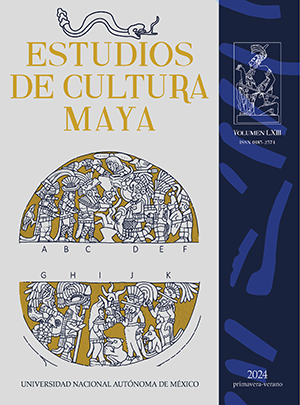No tan imposible: la llegada de los toltecas de Tula a Chichén Itzá
Contenido principal del artículo
Resumen
El debate sobre la relación de las ciudades prehispánicas de Tula y Chichén Itzá ha polarizado la interpretación de la historia de Mesoamérica, desde quienes niegan cualquier contacto directo, hasta quienes sostienen que estos contactos existieron en forma de invasiones o migraciones. En este trabajo presentamos evidencia epigráfica que refuerza la relación directa entre ambas ciudades, y que se añade a la considerable evidencia iconográfica y arquitectónica de tal nexo.
Detalles del artículo

Esta obra está bajo una licencia internacional Creative Commons Atribución-NoComercial 4.0.
El autor o autores se compromete(n) a firmar una declaración autorizando la publicación en los distintos soportes y espacios de difusión de Estudios de CulturaMaya y cediendo los derechos patrimoniales sobre la obra en forma total y exclusiva a la Universidad Nacional Autónoma de México, conforme a lo establecido en el artículo 84 de la Ley Federal del Derecho de Autor y demás relativos y aplicables a su reglamento, en el entendido de que será respetado su derecho autoral sobre la obra, se les otorgará el crédito correspondiente y recibirá(n) un ejemplar del número de Estudios donde aparezca el artículo
Citas
Acosta, Jorge. 1956-1957 “Interpretación de algunos datos obtenidos en Tula relativos a la época tolteca”, Revista Mexicana de Estudios Antropológicos, 14: 75-160.
Adams, Richard E. W. 1977 Prehistoric Mesoamerica. Boston: Little Brown.
Andrews, Anthony P., E. Wyllys Andrews IV y Fernando Robles C. 2003 “The Northern Maya Collapse and its Aftermath”, Ancient Mesoamerica, 14 (1): 151-156.
Andrews IV, E. Wyllys. 1970 Balankanche: Throne of the Tiger Priest. New Orleans: Middle American Research Institute, Publ. 32, Tulane University.
Andrews V, E. Wyllis y Jeremy A. Sabloff. 1986 “Classic to Postclassic: A Summary Discussion”, Late Lowland Maya Civilization: Classic to Postclassic, pp. 433-456, Jeremy A. Sabloff y E. Wyllis Andrews IV (eds.). Albuquerque: University of New Mexico.
Ball, Joseph W. 1979 “Ceramics, Culture History and the Puuc Traditions: Some Alternative Possibilities”, The Puuc: New Perspectives, pp. 18-35, Lawrence Mills (ed.). Pella, Indiana: Central College.
Bíró, Péter y Eduardo Pérez de Heredia. 2016 “The Caracol Disk of Chichén Itzá (929-932 ce): Some Thoughts on Epigraphy and Iconography”, Estudios de Cultura Maya, XLVIII: 129-162.
Boot, Erik. 2005 Continuity and Change in Text and Image at Chichén Itzá, Yucatán, México: A Study of the Inscriptions, Iconography, and Architecture at Late Classic to Early Postclassic Maya Site. Leiden, Netherlands: School of Asian, African and American Studies.
Borowicz, James. 2003 “Images of Power and the Power of Images: Early Classic Iconographic Programs of the Carved Monuments of Tikal”, The Maya and Teotihuacan: Reinterpreting Early Classic Interaction, pp. 217-234, Geoffrey E. Braswell (ed.). Austin: University of Texas Press.
Brinton, Daniel G. 1887 “Were the Toltecs an Historic Nationality?”, Transactions of the American Philosophical Society, 24: 229-241.
Carter, Nicholas. 2014 “Kingship and Collapse: Inequality and Identity in the Terminal Classic Southern Maya Lowlands”, tesis de doctorado. Rhode Island: Brown University.
Carter, Nicholas y Katharine W. Lukach. 2023 “Terminal Classic Conch-Shell Gorgets from the Maya Region and Central Mexico”, Ancient Mesoamerica 1-15, doi: 10.1017/S0956536122000360.
Charnay, Désiré. 1885 “La civilisation Tolteque”, Revue d’Ethnographie, 4: 281-305.
Charnay, Désiré. 1887 Ancient Cities of the New World: Being Voyages and Explorations in México and Central America from 1857-1882. Nueva York: Harper and Brothers.
Clancy, Flora S. 1999 Sculpture in the Ancient Maya Plaza: the Early Classic Period. Albuquerque: University of New Mexico Press.
Coe, Michael y Stephen D. Houston. 2015 The Maya. London: Thames and Hudson.
Cowgill, George. 1996 “Discussion, Special Section: Recent Chronological Research in Central México”, Ancient Mesoamerica, 7: 325-332.
Davies, Nigel. 1977 Toltecs: Until the Fall of Tula. Norman: University of Oklahoma Press.
Davletshin, Albert. 2014 “La lengua de los así llamados teotihuacanos e interpretaciones protonahuas para sus glosas en las inscripciones jeroglíficas mayas”, manuscrito no publicado, Moscú.
Davletshin, Albert. 2021 “Descripción funcional de la escritura jeroglífica náhuatl y una lista de términos técnicos para el análisis de sus deletreos”, Estudios Cultura Náhuatl, 62: 43.93.
Diehl, Richard A. 1974 “Summary and Conclusions”, Studies of Ancient Tollan: A Report of the University of Missouri Tula Archaeological Project, pp. 190-195, Richard A. Diehl (ed.). Columbia: University of Missouri, Department of Anthropology (Monographs in Anthropology, vol. 1).
Diehl, Richard A. 1983 Tula: The Toltec Capital of Ancient México. Londres: Thames and Hudson.
Feldman, Lawrence H. 1974 “Tollan in Hidalgo: Native Accounts of the Central Mexican Tolteca”, Studies of Ancient Tollan: A Report of the University of Missouri Tula Archaeological Project, pp. 130-149, Richard A. Diehl (ed.). Columbia: University of Missouri, Department of Anthropology (Monographs in Anthropology, Vol. 1).
Freidel, David, Linda Schele y Joy Parker. 1993 Maya Cosmos: Three Thousand Years on the Shaman’s Path. Nueva York: Harper Collins Publishers.
Gallatin, Albert. 1845 “Notes on the Semi-Civilized Nations of México, Yucatán, and Central America”, Transactions of the American Ethnological Society, 1: 1-352.
Gillespie, Susan 2007 “Toltecs, Tula and Chichén Itzá: The Development of an Archaeological Myth”, Twin Tollans: Chichén Itzá, Tula, and the Epiclassic to Early Postclassic Mesoamerican World, pp. 85-128, Jeff Karl Kowalski y Cynthia Kristan-Graham (eds.). Washington: Dumbarton Oaks Research Library and Collection.
Grube, Nikolai y Ruth Krochock. 2007 “Reading between the Lines: Hieroglyphic Texts from Chichén Itzá and Its Neighbors”, Twin Tollans: Chichén Itzá, Tula, and the Epiclassic to Early Postclassic Mesoamerican World, pp. 205-250, Jeff Karl Kowalski y Cynthia Kristan-Graham (eds.). Washington: Dumbarton Oaks Research Library and Collection.
Gubler, Ruth. 1993 “Datos genealógicos inéditos del linaje Cocom de Yucatán”, Mesoamérica, 25: 1-26.
Guenter, Stanley P. 2019 “The Return of the Toltecs: Reconsidering the ’Toltec Invasion Hypothesis’ at Chichén Itzá”, Mayanist, 1 (1): 59-74.
Hassig, Ross. 1992 War and Society in Ancient Mesoamerica. Los Angeles: University of California Press.
Helmke, Christophe. 2017 “El pasado en un país lejano: un análisis epigráfico de los textos mayas de Tetitla, Teotihuacan”, Las pinturas realistas de Tetitla, Teotihuacan: Estudios a través de la obra de Agustín Villagra Caleti, pp. 101-134, Leticia Staines Cincero y Christophe Helmke (eds.). México: Universidad Nacional Autónoma de México/Instituto Nacional de Antropología e Historia.
Houston, Stephen D. 2004 “The Archaeology of Communication Technologies”, Annual Review of Anthropology, 33: 223-250.
Jiménez Moreno, Wigberto. 1941 “Tula y los toltecas según las fuentes históricas”, Revista Mexicana de Estudios Antropológicos, 5: 79-83.
Jiménez Moreno, Wigberto. 1956 “Síntesis de la historia precolonial del Valle de México”, Revista Mexicana de Estudios Antropológicos, 14: 219-236.
Jones, Lindsay. 1993 “The Hermeneutics of Sacred Architecture: A Reassessment of the Similitude between Tula, Hidalgo, and Chichén Itzá, Yucatan, Part II”, History of
Religions, 32 (4): 315-342.
Jordan, Keith. 2016 “From Tu la Chico to Chichén Itzá: Implications of the Epiclassic Sculpture of Tula for the Nature and Timing of Tula-Chichén Contact”, Latin American Antiquity, 27 (4): 462-478.
Katz, Friedrich. 1972 Ancient American Civilizations. Nueva York: Praeger.
Kaufman, Terrence y John Justeson. 2001 Epi-Olmec Hieroglyphic Writing and Texts, <https://www.albany.edu/pdlma/EOTEXTS.pdf>.
Kirchhoff, Paul. 1955 “Quetzalcoatl, Huemac y el fin de Tula”, Cuadernos Americanos, 14 (6): 163-196.
Krickeberg, Walter. 1961 “Observaciones acerca de las esculturas y monumentos de Cotzumalhuapa”, Antropología e Historia de Guatemala, 13 (2): 3-13.
Kristan-Graham, Cynthia. 1989 “Art, Rulership and the Mesoamerican Body Politic at Tula and Chichén Itzá”, tesis de doctorado. Los Angeles: University of California, Department of Anthropology.
Kristan-Graham, Cynthia. 2014 “Name Signs at the Temple of the Warriors Complex, Chichén Itzá, Yucatán”, manuscrito no publicado.
Kowalski, Jeff K. y Cynthia Kristan-Graham (eds.). 2007 Twin Tollans: Chichén Itzá, Tula, and the Epiclassic to Early Postclassic Mesoamerican World. Washington: Dumbarton Oaks Research Library and Collection.
Kubler, George A. 1961 “Chichén Itzá and Tula”, Estudios de Cultura Maya, 1: 47-80.
Lacadena, Alfonso. 2008 “Regional Scribal Traditions: Methodological Implications for the Decipherment of Nahuatl Writing”, pari Journal, 8 (4): 1-22.
Lincoln, Charles. 1986 “The Chronology of Chichén Itzá: A Review of the Literature”, Late Lowland Maya Civilization: Classic to Postclassic, pp. 141-156, Jeremy A. Sabloff y E. Wyllis Andrews IV (eds.). Albuquerque: University of New Mexico.
López Austin, Alfredo. 1973 Hombre-Dios: religión y política en el mundo náhuatl. México: Universidad Nacional Autónoma de México, Instituto de Investigaciones Históricas (Serie de Cultura Náhuatl, 15).
López Austin, Alfredo y Leonardo López Lujan. 1999 Mito y realidad de Zuyúa: serpiente emplumada y las transformaciones mesoamericanas del Clásico al Posclásico. México: Colegio de México.
López Austin, Alfredo y Leonardo López Lujan. 2000 “Myth and Reality of Zuyúa: The Feathered Serpent and Mesoamerican Transformations from the Classic to the Postclassic”, Mesoamerica’s Classic Heritage, pp. 21-84, David Carrasco, Lindsay Jones y Scott Sessions (eds.). Niwot: University Press of Colorado.
Love, Bruce y Meghan Rubenstein. 2022 “A Catalog of Non-Maya Glyphs at Chichén Itzá: Second Edition”, Contributions to Mesoamerican Studies, November 28, 2022, <https://brucelove.com/research/contribution-012/>.
Love, Bruce y Peter Schmidt. 2011 Catálogo preliminar de glifos ajenos de la tradición maya en Chichén Itzá. Mérida: Instituto Nacional de Antropología e Historia, Proyecto Arqueológico Chichén Itzá.
Martin, Simon. 2020 Ancient Maya Politics: A Political Anthropology of the Classic Period 150-900 ce. Cambridge: Cambridge University Press.
Martin, Simon. 2023 “Ethnicity and Identity at Chichen Itza”, When East Meets West. Chichen Itza, Tula, and the Postclassic Mesoamerican World, pp. 585-634, Travis W. Stanton, Karl A. Taube, Jeremy D. Coltman, and Nelda I. Marengo Camacho (eds.). Oxford: BAR Publishing.
Mastache, Alba Guadalupe, Robert H. Cobean y Dan M. Healan. 2002 Ancient Tollan: Tula and the Toltec Heartland. Boulder: University Press of Colorado.
Maudslay, Alfred P. 1889-1902 Archaeology: Biologia Centrali-Americana, or, Contributions to the Knowledge of the Fauna and Flora of México and Central America. Londres: R. H. Porter and Dulau and Co., 5 tomos.
Mendizábal, Miguel de y Enrique Palacios. 1920 El Templo de Quetzalcóatl en Teotihuacan. México: Imprenta del Museo Nacional de Arqueología.
Mendizábal, Miguel de y Enrique Palacios. 1921 Quetzalcóatl y la irradiación de su cultura. México: Imprenta del Museo Nacional de Arqueología.
Montgomery, John. 1995 “Sculptures of the Realm: Classic Maya Artists’ Signatures and Sculptural Style during the Reign of Piedras Negras Ruler 7”, tesis de maestría. Albuquerque: University of New Mexico.
Morley, Sylvanus. 1946 The Ancient Maya. Stanford: Stanford University Press.
Morley, Sylvanus y George W. Brainerd. 1956 The Ancient Maya. Stanford: Stanford University Press.
Morris, Earl H., Jean Charlot y Ann Axtell Morris. 1931 The Temple of the Warriors at Chichén Itzá, Yucatán. Washington: Carnegie Institution of Washington.
Nicholson, Henry B. 1979a “Correlating Mesoamerican Historical Traditions with Archaeological Sequence: Some Methodological Considerations”, Proceedings of the International Congress of Americanists (42 session, Paris, 1976), v. 9B, pp. 187-198. Paris.
Nicholson, Henry B. 1979b “Ehecatl Quetzalcoatl vs. Topiltzin Quetzalcoatl of Tollan: A Problem in Mesoamerican Religion and History”, Proceedings of the International Congress of Americanists (42 session, Paris, 1976), v. 6, pp. 35-47. Paris.
Nielsen, Jesper, Claudia Alvarado León y Christophe Helmke. 2021 “The Stuccoed and Painted Benches of Xochicalco, Morelos, México”, Ancient Mesoamerica, 32: 249-268, doi: 10.1017/S0956536120000012.
Pérez de Heredia, Eduardo. 2010 “Ceramic Contexts and Chronology at Chichén Itzá, Yucatán, México”, tesis de doctorado en Arqueología. Melbourne: La Trobe University, .
Pérez de Heredia, Eduardo y Péter Bíró. 2020 La Casa Real de Cocom. Una historia de Yucatán,<https://www.academia.edu/44631362/LA_CASA_REAL_DE_COCOM_UNA_HISTORIADE_YUCAT%C3%81N>.
Price, Douglas T., Vera Tiesler y Carolyn Freiwald. 2019 “Place of Origin of the Sacrificial Victims in the Sacred Cenote, Chichén Itzá, Mexico”, American Journal of Physical Anthropology, 1-18.
Proskouriakoff, Tatiana. 1950 A Study of Classic Maya Sculpture. Washington: Carnegie Institution.
Proskouriakoff, Tatiana. 1951 “Some Non-Classic Traits in Sculpture of Yucatán”, Proceedings of the 29th International Congress of Americanists. Chicago: University of Chicago Press, pp. 108-118.
Rattray, Evelyn C. 1993 The Oaxaca Barrio at Teotihuacan. Puebla: Instituto de Estudios Avanzados, Universidad de las Américas-Puebla (Monografías Mesoamericanas 1).
Ringle, William. 2004 “On the Political Organization of Chichén Itzá”, Ancient Mesoamerica, 15: 167-218.
Ringle, William. 2009 “The Art of War: Imagery of the Upper Temple of the Jaguars, Chichén Itzá”, Ancient Mesoamerica, 20: 15-44.
Ringle, William. 2017 “Debating Chichén Itzá”, Ancient Mesoamerica, 28: 119-136.
Ringle, William. 2020 “The Northern Maya Tollans”, The Maya World, pp. 752-772, Scott R. Hutson y Traci Ardren (eds.). Londres/Nueva York: Routledge.
Ringle, William, Tomás Gallareta N. y George J. Bey. 1998 “The Return of the Quetzalcoatl: Evidence for the Spread of the World Religion during the Epiclassic Period”, Ancient Mesoamerica, 9: 183-132.
Robles Castellanos, Fernando y Anthony P. Andrews. 1986 “A Review and Synthesis of Recent Postclassic Archaeology in Northern Yucatan”, Late Lowland Maya Civilization: Classic to Postclassic, pp. 53-98, Jeremy A. Sabloff y E. Wyllis Andrews IV. Albuquerque: University of New Mexico.
Ruz Lhuillier, Alberto. 1962 “Chichén Itzá y Tula: comentarios a un ensayo”, Estudios de Cultura Maya, 2: 205-220.
Schele, Linda y David Freidel. 1990 A Forest of Kings: The Untold Story of the Ancient Maya. Nueva York: William Morrow and Co. Inc.
Schele, Linda y Peter Mathews. 1999 The Code of Kings. The Language of Seven Sacred Maya Temples and Tombs. Nueva York: A Touchstone Book published by Simon & Schuster.
Schmidt, Peter. 1999 “El Puuc y la secuencia de Chichén Itzá”, Hidden among the Hills: Maya Archaeology of the Northwest Yucatán Peninsula, First Teobert Maler Simposium, Acta Mesoamericana, vol. 7. Hann J. Prem (ed.). Saurwein, Bonn: Instituto Nacional de Antropología e Historia/Universidad de Markt Schwaben.
Schmidt, Peter. 2003 Proyecto Chichén Itzá: Informe de actividades, julio de 1999 a diciembre de 2002.
Schmidt, Peter J., David Stuart y Bruce Love. 2008 “Inscriptions and Iconography of Castillo Viejo, Chichén Itzá”, pari Journal, IX (2): 1-17.
Schmidt, Peter J., Péter Bíró y Eduardo Pérez de Heredia. 2018 “El Templo de los Búhos de Chichén Itzá y su emplazamiento cronológico: una nueva propuesta”, Estudios de Cultura Maya, LII: 11-49.
Seler, Edward. 1996 [1923] “The Principal Myth of the Mexican Tribes and the Culture Heroes of Tollan”, Collected Works in Mesoamerican Linguistics and Archaeology, vol. 5, pp. 59-92, Frank E. Comparato (ed.). Lancaster, California: Labyrinthos.
Smith, Michael E. y Lisa Montiel 2001 “The Archaeological Study of Empires and Imperialism in Prehispanic Central Mexico”, Journal of Anthropological Archaeology, 20: 245-284.
Spinden, Herbert J. 1917 Ancient Civilizations of Mexico and Central America. Nueva York: American Museum of Natural History (Handbook Series, 3).
Sterpone, Osvaldo J. 2000-2001 “La quimera de Tula”, Boletín de Antropología Americana, 37: 141-204.
Sugiyama, Saburo y Sugiyama Nawa. 2020 “Interactions between the Ancient Teotihuacan and the Maya World”, The Maya World, pp. 689-711, Scott R. Hutson y Traci Ardren (eds.). Londres/Nueva York: Routledge.
Taube, Karl. 2003 “Tetitla and the Maya Presence at Teotihuacan”, The Maya and Teotihuacan: Reinterpretation Early Classic Interaction, pp. 273-314, Geoffrey E. Braswell (ed.). Austin: University of Texas Press.
Taube, Karl. 2011 “Teotihuacan and the Development of Writing in Early Classic Central Mexico”, Their Way of Writing: Scripts, Signs, and Pictographies in Pre-Columbian America, pp. 77-109, Elizabeth H. Boone y Gary Urton (eds.). Washington, dc: Dumbarton Oaks Research Library and Collection.
Thompson, J. Eric S. 1970 Maya History and Religion. Norman: University of Oklahoma Press.
Tozzer, Alfred M. 1930 “Maya and Toltec figures at Chichén Itzá”, Proceedings of the International Congress of Americanists (23 session, New York, 1928), pp. 155-164. New York.
Tozzer, Alfred M. 1957 Chichén Itzá and its Cenote of Sacrifice: Comparative Study of Contemporaneous Maya and Toltec. Cambridge: Harvard University (Memoirs of the Peabody Museum, 11, 12).
Urcid Serrano, Javier. 2001 Zapotec Hieroglyphic Writing. Washington: Dumbarton Oaks (Studies in Pre-Columbian Art and Archaeology, 34).
Vaillant, George A. 1962 Aztecs of México. Origin, Rise and Fall of the Aztec Nation. Garden City: Doubleday, Doran and Company.
Vaillant, George A. 1965 Aztecs of Mexico. Baltimore: Penguin Book.
Veytia, Mariano. 1994 [1836] Historia antigua de México, 2 vols. México: Editorial Leyenda.
Volta, Beniamino y Geoffrey E. Braswell. 2014 “Alternative Narratives and Missing Data: Refining the Chronology of Chichén Itzá”, The Maya and their Central American Neighbours: Settlement Patterns, Architecture, Hieroglyphic Texts, and Ceramics, pp. 356-403, Geoffrey E. Braswell (ed.). Londres/Nueva York: Routledge.
Weaver, Muriel Porter. 1972 Aztecs, Maya, and their Predecessors: Archaeology of Mesoamerica. Nueva York: Seminar Press.
Whittaker, Gordon. 2009 “The Principles of Nahuatl Writing”, Göttinger Beiträge zur Sprachwissenschaft, 16: 47-91.
Willey, Gordon. 1966 An Introduction to American Archaeology, vol. I, North and Middle America. Englewood Cliffs, New Jersey: Prentice-Hall.
Wyllie, Cherra. 2008 “Continuity and Change in Late Classic Southern Veracruz Art, Hieroglyphs, and Religion”, Classic Period Cultural Currents in Southern and Central Veracruz, pp. 225-258, Philip J. Arnold y Christopher A. Pool (eds.). Washington: Dumbarton Oaks.
Wright, Lori E. 2005 “In Search of Yax Nuun Ayiin I: Revisiting the Tikal Project’s Burial 10”, Ancient Mesoamerica, 16: 89-100.
Zender, Mark. 2008 “One Hundred and Fifty Years of Nahuatl Decipherment”, pari Journal, 8 (4): 24-37.






